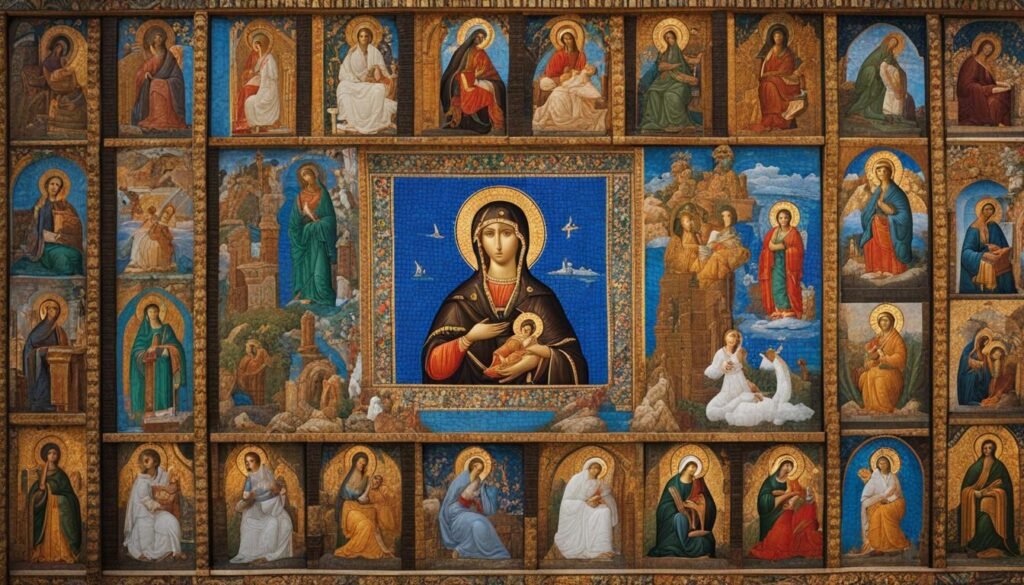The Angelus is a traditional Catholic prayer that has its roots in the 13th century. It is typically recited three times a day, usually at 6 AM, noon, and 6 PM. The prayer focuses on the mystery of the Incarnation and is a reflection on the role of Mary in God’s plan of salvation. It consists of three Hail Marys with antiphons and responses in between each. Praying the Angelus is seen as a way to interrupt daily tasks and make space for God and prayer. By saying “yes” to God in the Angelus, individuals are invited to deepen their relationship with Him and participate in the mystery of the Incarnation.
Key Takeaways:
- The Angelus is a traditional Catholic prayer dating back to the 13th century.
- It is recited three times a day and focuses on the mystery of the Incarnation and the role of Mary.
- Praying the Angelus interrupts daily tasks and invites individuals to deepen their relationship with God.
- It consists of three Hail Marys with antiphons and responses in between.
- The Angelus prayer provides a way to participate in the mystery of the Incarnation and honor the role of Mary in God’s plan of salvation.
The Significance of the Angelus in Catholic Schools
The Angelus holds a special significance in Catholic schools, where it is often recited as a communal prayer. It serves as a powerful demonstration of the importance of making time for prayer amidst the hustle and bustle of daily activities. By coming together as a community to recite the Angelus, students are reminded that no task is more important than prayer and that through prayer, they can find meaning in their work and invite God into their lives. The Angelus also offers the opportunity for students to say their own “yes” to God, mirroring the “yes” of Mary in accepting God’s will.
Praying the Angelus regularly in Catholic schools helps to cultivate a habit of prayer among students. It encourages them to pause, reflect, and connect with their faith throughout the day. Through the Angelus, students can deepen their understanding of the mysteries of the faith and their relationship with God. It serves as a constant reminder of the profound role that prayer plays in their lives and invites them to be active participants in the Catholic tradition of devotion.
Furthermore, the Angelus prayer provides students with a sense of unity and belonging within the school community. As they join together in prayer, they experience a bond that goes beyond academic pursuits. The Angelus becomes a shared experience that connects students, teachers, and staff on a spiritual level. Through this communal prayer, Catholic schools foster an environment that values prayer, faith, and the rich traditions of the Catholic Church.
The Importance of Catholic Daily Prayer
Table: Examples of Catholic Prayers for Daily Use
| Prayer | Description |
|---|---|
| Our Father | The Lord’s Prayer, taught by Jesus to His disciples |
| Hail Mary | A prayer that seeks the intercession of the Blessed Virgin Mary |
| Glory Be | A prayer that gives praise and glory to the Holy Trinity |
| Act of Contrition | A prayer expressing sorrow for sins and a desire for forgiveness |
| Rosary | A devotion that combines the recitation of prayers with meditation on the life of Jesus and Mary |
Table: Examples of Catholic Prayers for Daily Use
- Make time for prayer amidst daily activities
- Recite the Angelus as a communal prayer in schools
- Encourage students to say their own “yes” to God
- Cultivate a habit of prayer among students
- Deepen understanding of the mysteries of the faith
- Foster unity and a sense of belonging within the school community
How to Pray the Angelus
The Angelus prayer is a beautiful and simple practice that can be incorporated into daily life. To begin, set a specific time each day to pray the Angelus, whether it’s in the morning, noon, or evening. This designated time will help you establish a routine and ensure that you don’t forget to pray. You can associate the Angelus prayer with an existing habit, such as right before or after a meal, or use a reminder on your phone or computer to prompt you.
When praying the Angelus, it’s important to follow the call and response format. Start by making the sign of the cross and reciting the opening words: “The Angel of the Lord declared unto Mary.” Then, respond with the traditional response: “And she conceived of the Holy Spirit.” Repeat this for the second and third lines of the prayer as well.
After the response, recite the Hail Mary three times. You can use a rosary or keep count on your fingers if it helps. Once the Hail Marys are completed, conclude the prayer with the closing words: “Pray for us, O holy Mother of God, that we may be made worthy of the promises of Christ.” Again, respond with the traditional response: “Let us pray.” Finally, say the concluding prayer: “Pour forth, we beseech thee, O Lord, thy grace into our hearts; that we, to whom the Incarnation of Christ, thy Son, was made known by the message of an angel, may by his Passion and Cross, be brought to the glory of his Resurrection. Through the same Christ, our Lord. Amen.”
Table: Steps to Pray the Angelus
| Step | Description |
|---|---|
| 1 | Set a specific time each day to pray the Angelus. |
| 2 | Begin with the opening words and responses. |
| 3 | Recite three Hail Marys. |
| 4 | Conclude with the closing words and prayer. |
Praying the Angelus is a wonderful way to center your day around God and reflect on the mystery of the Incarnation. It allows you to pause, even for just a few moments, and acknowledge the significance of Mary’s role in God’s plan of salvation. As you make the Angelus prayer a part of your daily life, you will deepen your relationship with God and find peace and solace in His presence.

The History and Cultural Significance of the Angelus
The Angelus prayer has a rich history and holds significant cultural importance. Originating in the 13th century, it has been embraced by the Catholic Church and has become a cherished tradition. The structure of the prayer, its biblical content, and its association with the prayer for peace make it a timeless and esteemed practice.
“The Angelus has been an integral part of our Catholic heritage for centuries. It serves as a beautiful reminder of the mystery of the Incarnation and the pivotal role that Mary played in our salvation,” says Sister Mary, a Benedictine nun.
While the frequency of recitation has decreased in recent years, the Angelus is still observed in various religious communities, such as convents and monasteries. Its significance extends beyond Catholicism, having found a place in the wider Christian tradition. Modified versions of the prayer are included in the Book of Common Prayer, demonstrating its universal appeal.
The Angelus prayer invites contemplation on the mystery of the Incarnation and offers believers a way to remember and honor the role of Mary in the life of Jesus. Through the recitation of the Angelus, individuals can deepen their faith and cultivate a sense of peace and connection with God.
The Cultural Significance of the Angelus
The Angelus holds a special place in the hearts of many Catholics around the world. Its recitation serves as a moment of pause and reflection, allowing individuals to connect with their faith and find solace in the presence of God. The prayer’s focus on peace and the Incarnation resonates with people from various cultural backgrounds, transcending religious boundaries.
| Country | Angelus Traditions |
|---|---|
| Italy | In Italy, the Angelus is traditionally recited at noon, accompanied by the ringing of church bells as a call to prayer. |
| Spain | In Spain, the Angelus is often recited before the main meal of the day, bringing families and communities together in prayer and gratitude. |
| Ireland | In Ireland, the Angelus is broadcasted on television and radio, allowing the entire nation to pause and reflect in unity. |
These cultural traditions surrounding the Angelus highlight its enduring significance and impact on individuals and communities around the world. The prayer serves as a reminder of the universal need for prayer, peace, and connection with the divine.
A Convergent Approach to the Angelus Prayer
The Angelus prayer has a unique potential to bridge the gap between different Christian denominations through a convergent approach. By emphasizing the common elements of the prayer and incorporating language rooted in the Bible, the Angelus can become more accessible to Protestant Christians. This convergence Mariology, centered around the mystery of the Incarnation and the role of Mary in God’s plan of salvation, can foster a sense of unity among believers from various backgrounds.
By embracing the Angelus prayer, Christians of different denominations can find common ground and engage in shared devotion. The prayer’s focus on the Incarnation resonates with the core beliefs of Christianity, emphasizing the significance of Christ’s birth and the role Mary played in this pivotal event. Through the Angelus, believers are invited to reflect on God’s plan of salvation and the invitation to say “yes” to God’s will, just as Mary did.
Benefits of Convergence Mariology
Convergence Mariology offers several benefits to believers. Firstly, it provides a shared language of devotion and prayer that can unify Christians across denominational lines. By incorporating elements of the Angelus into their spiritual practice, believers can deepen their understanding of the mysteries of the faith and cultivate a sense of shared spirituality.
Furthermore, convergence Mariology encourages dialogue and ecumenical cooperation. It opens the door for discussions on theological similarities and shared traditions, fostering a spirit of collaboration and understanding among Christians. As believers come together to pray the Angelus, they can learn from one another’s perspectives, enrich their own faith, and build bridges of unity.
Ultimately, the convergent approach to the Angelus prayer promotes a sense of unity and shared spirituality among Christians of different denominations. By embracing this traditional Catholic devotion and adapting it to resonate with the beliefs and practices of other Christian traditions, believers can find common ground and deepen their relationship with God.

| Denomination | Prayer Traditions | Similarities with the Angelus |
|---|---|---|
| Catholic | Angelus, Liturgy of the Hours | Emphasis on the role of Mary, prayer at specific times |
| Protestant | Devotional prayers, morning and evening prayers | Focus on the Incarnation, reflection on God’s plan of salvation |
| Orthodox | Canonical hours, prayers to the Theotokos | Importance of Mary in salvation history, reflection on God’s will |
Conclusion
The Angelus prayer is a cherished tradition in the Catholic faith, deeply rooted in the 13th century. It is a daily practice that allows individuals to pause amidst their daily tasks and create space for God and prayer. By reciting the Angelus, believers reflect on the profound mystery of the Incarnation and honor the role of Mary in God’s plan of salvation.
Regularly engaging in the Angelus prayer leads to a deeper relationship with God and a greater understanding of the mysteries of the faith. This traditional Catholic devotion invites individuals to say their own “yes” to God, following in the footsteps of Mary’s acceptance of God’s will.
Furthermore, the Angelus has the potential to be a unifying practice across different Christian denominations. By embracing a convergent approach, the Angelus can be appreciated by believers of various backgrounds, contributing to Christian unity and shared devotion. It is a prayer that highlights the importance of pausing for prayer, inviting believers to deepen their faith and grow closer to God.
FAQ
What is the origin of the Angelus prayer?
The Angelus prayer has its roots in the 13th century.
How often is the Angelus typically recited?
The Angelus is typically recited three times a day: at 6 AM, noon, and 6 PM.
What is the purpose of the Angelus prayer?
The Angelus prayer focuses on the mystery of the Incarnation and reflects on the role of Mary in God’s plan of salvation.
Why is the Angelus significant in Catholic schools?
The Angelus prayer is often recited as a communal prayer in Catholic schools, teaching students the importance of making time for prayer amidst their daily activities.
How can I incorporate the Angelus prayer into my daily life?
Set a specific time each day to pray the Angelus and memorize the call and response format of the prayer over time. Additional times for prayer can be added once the daily habit is established.
What is the history and cultural significance of the Angelus?
The Angelus originated in the 13th century and is officially recognized by the Catholic Church. It holds indulgences and has associations with the prayer for peace and safety.
Can the Angelus prayer be appreciated by Christians of different denominations?
Yes, with a convergent approach, the Angelus prayer can be modified to include language rooted in the Bible and be appreciated by Christians of different denominations.








